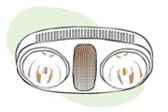
The right electrical fittings and outlets will provide a nice complement to the rest of your design.
Electricity is used all over bathrooms, for lighting, ventilation and to supply power to appliances. Electricity can be safely used in a bathroom, but extra precautions are necessary, because they’re humid, wet places – an accident with electricity in a bathroom could easily be fatal. Wet rooms in particular need outlets and fittings to be carefully positioned, to ensure that splashes and condensation don’t create an electrocution hazard.
Height and position
General power outlets (GPOs) and light switches in bathroom need to be located in accordance with regulations. These regulations pertain mostly to their positioning with respect to water outlets like faucets and shower heads, as welll as their height, in case of flooding. Power outlets are normally best positioned near to the vanity unit, where most of your grooming appliances will be used. To confirm the safety of your power outlets, discuss where they’re going to be located with a qualified electrician.

Bathroom heaters
Heating is incredibly important in a bathroom, not only for those cold winter mornings, but also to help dry the bathroom out after use and to prevent mould and other moisture-related problems. Whether your heating is incorporated into your lighting or is connected separately as you’d see with a bar heater, it is highly likely that it will need to be connected to the power supply in some capacity.
Heat lamps are very common in homes across Australia and they are available in a number of different styles and configurations. Warmth is radiated downward from lamps, which provide light as well as heat and having them serve this dual purpose makes them somewhat more efficient. Special globes are required in heat lamps, which are more expensive than regular globes to replace.
Exhaust fans
Some heat lamp units also incorporate a fan into the design, which allows you to integrate all your ceiling electrics together in one place. This may not be convenient in all circumstances though, as the heat lamp will need to be located centrally in the bathroom while the fan is normally best positioned where the most steam will be generated – usually over the shower. If your shower is too far away from the centre of the room, this type of fan will be far less effective.
A good exhaust fan should be kept clear of any obstructions, as it will be regulating the air flow of your bathroom and is the best way to prevent moisture build-up. Make sure the fan’s intake and blades are cleaned regularly to keep them free from dust. Roof mounted exhaust fans normally incorporate a duct leading out to the roof. This ensures that the fan isn’t just blowing the steam out into your ceiling cavity, which would cause the exact problems there that you’re trying to stop in your bathroom. Ducting can cost a little bit to install, but is worth it. Some bathrooms are able to have the fan mounted directly on a wall leading outside, which removes the need for ducting altogether. Circumstances will vary depending on your design though, and this may not always be an option.




